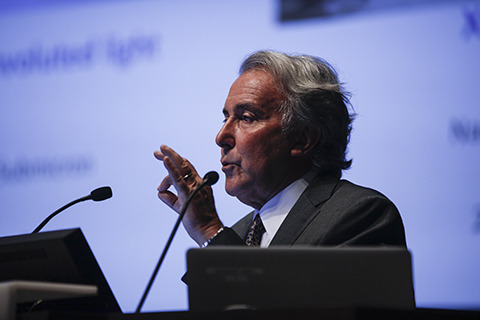Corday Winner Sees Big Future in Tiny Particles
Today's cardiologists perform a host of leading-edge procedures using catheters, including coronary angioplasty to open clogged arteries and stent implants to prevent cleared arteries from collapsing. What will they be doing in 50 years?

Julio Palmaz, MD, presenting "A Vision of the Future of Interventional Cardiology."
A capacity crowd at Harvey Morse Auditorium recently received a prediction from an authoritative source—Julio C. Palmaz, MD, whose Palmaz stent helped revolutionize treatment of coronary artery disease in the 1990s.
Palmaz was at Cedars-Sinai on May 8 to accept the Smidt Heart Institute's 2018 Eliot Corday, MD, International Prize in Heart Research, which recognizes physicians and scientists who have conducted groundbreaking research in cardiology or cardiac surgery.
In his lecture at the award ceremony, Palmaz predicted that the biggest breakthroughs in catheter-based or interventional cardiology will come from the smallest of particles. "I think there will be a complete departure from current interventional devices," he said. "Developers must move past mere refinements in existing stent design to take advantage of nanotechnology."
Nanotechnology in medicine involves using particles as small as one-billionth of a meter to manipulate biological materials. Palmaz said he believes these so-called nanoparticles will be building blocks of future interventional devices.
"This evolutionary growth will require megacomputing capability, and the workplace of future interventional cardiology teams will put NASA control centers to shame," Palmaz said. He said he foresees these teams expanding to include molecular biologists, engineers, chemists, supercomputer scientists and nanomolecular architects.
In introductory remarks, Frank Litvack, MD, former co-director of the Cedars-Sinai Cardiovascular Intervention Center, said the Palmaz stent "ranks as one of the two most important contributions made to interventional cardiology." Litvack cited the originator of coronary balloon angioplasty, Andreas Gruentzig, MD (1939-85), as the other seminal contributor.
The Palmaz stent is a small, wire-mesh tube designed to support an artery's inner wall after angioplasty or to strengthen a weak artery and improve blood flow. The device, which can reduce heart attack risk and, potentially, the need for bypass graft surgery, was approved in the early 1990s by the U.S. Food and Drug Administration for use in peripheral arteries, followed by approval for coronary arteries. Several types of stents have since been developed, and about 600,000 stent procedures are performed annually in the U.S., according to the American Heart Association.
Today, Palmaz is the Ashbel Smith Professor at UT Health San Antonio (formerly known as University of Texas Health Science Center at San Antonio) and chief scientific adviser at Vactronix Scientific, a medical technology company.
The Corday Prize is named in honor of the late Eliot Corday, MD, who chaired the Cedars-Sinai Division of Cardiology for more than 10 years and made lasting contributions to cardiac medicine. The prize is funded by a gift from Brindell Gottlieb and her late husband, Milton.
